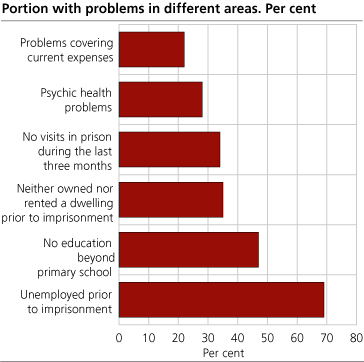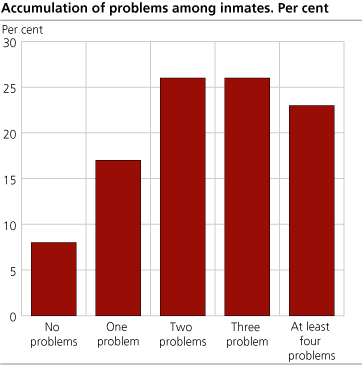Living conditions in prisons
Living condition problems among inmates
Published:
Inmates in Norwegian prisons have problems in several areas. Seven out of ten were unemployed at the time of imprisonment, nearly half have lower secondary school as their highest education, and two out of five live below the poverty level. These are some of the results of a survey among inmates in Norwegian prisons, conducted by Statistics Norway for the Fafo Institute for Applied Social Science.
Living conditions for inmates in Norwegian prisons are far worse than for the population at large. The majority of inmates are men aged 25–44 (65 per cent). They report difficult and complex living conditions. Many were unemployed and without permanent accommodation before imprisonment. Only half have completed education beyond lower secondary school and 25 per cent often have problems covering current expenses. Almost one third of the inmates suffer from mental health problems and approximately the same number have not been visited in prison in the last three months (figure 1). Three out of four say that they have problems on at least two of these areas (figure 2).
Difficult childhood
There is an evident correlation between problems while growing up and problems as an adult. Three out of ten had been in contact with the child welfare authorities before the age of 16 and many grew up in families with financial problems, unstable living conditions, abuse, illness and drug problems. More than two thirds of the inmates have experienced problems in one or more of these areas.
Opposite education pattern
Education levels among inmates in Norwegian prisons are just about the opposite from the rest of the population. Four out of ten have lower secondary school as their highest education, whereas this is the case for less than 10 per cent in the population at large. Very few inmates have education beyond upper secondary school. As a consequence this group have few formal skills to offer the labour market in a society where education levels in the population at large are increasing.
Widespread mental health problems
Inmates in Norwegian prisons are more likely to suffer from mental health problems than the rest of the population. In the population at large 10 per cent are suffering from such health problems, but among inmates the figure is three times as high. Three out of ten say that they needed treatment for mental health problems before imprisonment. This indicates that the problems they have today are not entirely attributable to the fact that they are in prison, but are also an effect of difficult living conditions before imprisonment. Still, we find that inmates who are kept in isolation are more likely to have mental health problems.
The survey was conducted by Statistics Norway for the Fafo Institute for Applied Social Science and financed by the Directorate for Health and Social Affairs and the Ministry of Justice. Comparisons with the population at large are mainly based on Statistics Norway's Survey of Living Conditions 2002.
Contact
-
Statistics Norway's Information Centre


